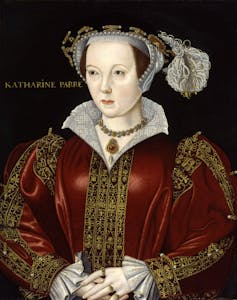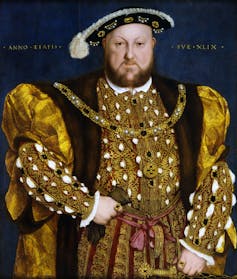It’s common knowledge that Henry VIII had six wives. But the cataclysmic love triangle between Catherine of Aragon and Anne Boleyn gets all the airtime, while wives three to six are an afterthought.
In director Alexander Korda’s rollicking film The Private Life of Henry VIII (1933), Katherine Parr (wife six) was reduced to a throwaway joke in the film’s last moments. Brazilian director Karim Aïnouz’s upcoming film Firebrand is the first to bring Parr to centre stage – and not before time.
Right on cue, new evidence has come to light giving an intriguing glimpse into Parr’s relationship with her capricious husband. Namely, the discovery of Henry’s notes in a book authored by his wife.
The bookish queen
Katherine Parr was unlike her five predecessors. Aged 30 and already twice widowed in 1543, the king made her an offer she couldn’t refuse, forcing her to break off another planned marriage. The increasingly disabled Henry had finally stopped pursuing nubile broodmares and sought out a companion instead.
Parr deftly navigated the tangled politics of the royal family, brokering a reconciliation between the king and the two daughters, Mary and Elizabeth, he had declared to be bastards. She may even have helped in restoring them to the line of succession.

Henry certainly came to trust her judgment. When he set off for his final, futile war in France in 1544, he made her regent in his absence. Part of the appeal, it seems, was her bookish piety. Parr was the first English queen to publish a book and the first English woman to publish under her own name.
Her three books were pious exercises, beginning with a safe collection of translated texts titled Psalmes or Prayers (1544) and becoming more daring thereafter. The Lamentation of a Sinner (1547) was written during Henry’s husband’s lifetime, but its theology was too assertively Protestant to be published until he was safely dead.
The earlier books, though, seem to have delighted the king. He inscribed the queen’s own copy of Psalmes or Prayers: “Remember this writer / when you do pray / For he is yours”. He had always been theatrically pious and in his last years – brooding, in pain, nurturing his many humiliations – he turned to religion with melancholy intensity.

We know what Henry thought religion should mean to his subjects: a tough, moralistic faith without much room for forgiveness, whose keynote was obedience to himself. But what about his personal faith?
Enter a new discovery by Canadian literary scholar Micheline White.
Queen Katherine ordered a few luxury copies of Psalmes or Prayers printed on vellum, with delicate hand colouring. One of these, now in Buckinghamshire’s Wormsley Library is festooned with marginal markings and “manicules” – little doodled hands with fingers pointing to a passage some reader wanted to emphasise.
White has established, by meticulously comparing these distinctive manicules with others whose provenance we know, that this attentive reader was none other than Henry VIII.
What Henry VIII’s notes reveal
It’s no surprise Henry should have taken comfort in the Biblical psalms. They were supposedly the work of a pious but lecherous king, David, with whom he strongly identified.
The passages Henry marked are a telling glimpse of the extent – and the limits – of his self awareness. His illness and other troubles are much on his mind: he marks prayers to “take away thy plagues … turn away thine anger”.
He is also drawn to prayers lamenting sin and asking God for wisdom. “Give me a new heart, and a right spirit, and take from me all wicked and sinful desires.”
The sentiments indicate a man who was serious both about his kingly responsibilities and personal spiritual predicament. Unlike many other murderous narcissists, Henry VIII did know he was a sinner who needed forgiveness. But his confidence “that my sins may be purged” suggests tension between the eagerness with which he sought grace and his refusal to countenance mercy – royal or divine – for his subjects.
Queen Katherine, as the popular rhyme tells us, “survived” her marriage, but it was a close run thing.
In 1546, the last summer of Henry VIII’s life, she was suspected – on good grounds – of nurturing a nest of religious radicals at court. Henry allowed himself to be persuaded that all her pious talk was actually an attempt to allure him into heresy.
According to a late but well-informed account by the martyrologist John Foxe, she got wind of the danger and immediately threw herself on his mercy. Katherine protested that she, a “poor woman so much inferior in all respects of nature unto you”, had simply been seeking his religious guidance.
“Not so, by Saint Mary,” Henry replied. “You are become a Doctor, Kate, to instruct us (as we take it) and not to be instructed, or directed by us.”
No, she protested: she had only sought to distract him with talk during “this painful time of your infirmity” and had in the process learned a great deal from his wisdom. With someone else, that might have been laying it on too thick, but she knew her man.
“And is it even so, sweetheart?” Henry replied. “Then perfect friends we are now again.” The arrest warrant was cancelled.
Months later, the king was dead. Unfortunately, Queen Katherine married the man she’d kept waiting with almost indecent haste – only to be cold shouldered when she fell pregnant and left to die in childbirth. History is thin on happy endings.
Alec Ryrie does not work for, consult, own shares in or receive funding from any company or organisation that would benefit from this article, and has disclosed no relevant affiliations beyond their academic appointment.
This article was originally published on The Conversation. Read the original article.







